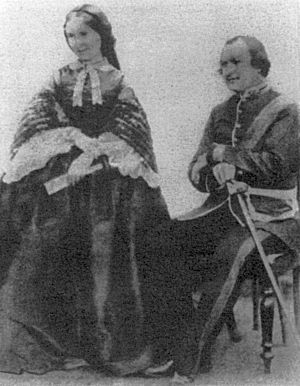Robert Christopher Tytler facts for kids
Robert Christopher Tytler (born September 25, 1818 – died September 10, 1872) was a British soldier, a person who studied nature (a naturalist), and a photographer. His second wife, Harriet C. Tytler, was famous for taking pictures of old buildings in Delhi and for her notes during the 1857 revolt in India. A mountain in the Andaman Islands, called Mount Harriet, is named after her. Also, a type of bird, Tytler's leaf warbler, is named after Robert Tytler.
Contents
Robert Tytler's Life Story
Robert Tytler's father, also named Robert Tytler, was a surgeon in the British Indian Army. His mother, Elizabeth Schneeburg, was the daughter of a German count. Robert Tytler went to school in Edinburgh, Scotland, and then joined the British army in Bengal, India, in 1834. He arrived in India in 1835 to join his father's army group.
He spent many years serving in the army in India. In 1842, he was promoted to manage the army's supplies. Later, he became an interpreter and quartermaster, which meant he helped with language and managing army living quarters. He also took part in the First Anglo-Afghan War (1839–1842).
During the first Anglo-Sikh War (1845–1846), Tytler was in charge of the money for the army's campaigns. After that, he traveled all over northern India with his army group.
The Indian Rebellion and Photography
In May 1857, when the Indian Rebellion of 1857 began, Tytler was in Delhi. He was there when soldiers from his own unit rebelled against their British officers. He played an important part in the fighting that followed. After the rebellion, he and his wife became important photographers. They took many pictures, including a famous one of the last Mughal Emperor, Bahadur Shah Zafar II.
Robert Tytler was eventually promoted to Colonel. He was also put in charge of the Convict Settlement at Port Blair in the Andaman Islands from April 1862 to February 1864. This was a place where prisoners were sent.
Family and Photography Work
Robert Tytler's first wife, Isabella, passed away in 1847 when she was only 21. The next year, Tytler married Harriet Christina Earle. She was also the daughter of an army officer. Harriet was very interested in photography and learned from other famous photographers.
After the 1857 rebellion, Harriet, who had a narrow escape, gave birth to a son. They named him Stanley Delhi-Force to remember the events. Today, Robert and Harriet Tytler are mostly remembered for their amazing photography. Together, they took about 300 photographs, some of which were very large panoramic pictures.
Harriet also wrote several memoirs, which are like personal journals or stories of her life, when she was in her seventies. These books shared her experiences in India.
A Love for Nature
Tytler was a very keen naturalist, meaning he loved to study nature. He was especially interested in birds, and he shared many of his notes with another naturalist, Allan Octavian Hume. He also collected amphibians (like frogs) and reptiles (like snakes and lizards). He even discovered new species, like a type of grassbird.
Tytler lived for a while in Shimla, India. There, he created a museum filled with his collections of birds, shells, rocks, old writings, and other interesting things from around India. This public museum was closed after he passed away in 1872. He had been ill for almost eight years.
Harriet Tytler offered to give the bird collections to Shimla, but they ended up in the Lahore Central Museum. Sadly, many of the specimens were damaged over time. Harriet also started a school for girls in 1869. Tytler also brought several types of birds, like common mynas and peafowl, to the Andaman Islands.
Tytler's son, Major-General Sir Harry Tytler, also joined the Indian Army and became a well-known naturalist, just like his father.
Things Named After Them
Several animals are named after Robert Tytler:
- Tytler's mabuya, a type of skink (a kind of lizard).
- Rana tytleri and Hylarana tytleri, which are both types of frogs.
- Tytler's leaf warbler, a small bird.
- An Asian subspecies of the barn swallow, a bird known for its long tail.
Mount Harriet in the Andaman Islands is named after his wife, Harriet Tytler.
Writings
Robert Tytler also wrote several scientific papers about his observations:
- Tytler RC. (1865). Description of a new species of Spizaetus. Proc. Asiatic Soc. Bengal 1865: 112.
- Tytler RC. (1865). Observations on a few species of geckos alive in the possession of the author. J. Asiatic Soc. Bengal 33 [1864]: 535–548.
- Tytler RC. (1868). Notes on the birds observed during a march from Simla to Mussoorie. Ibis 2 (4): 190–203.


